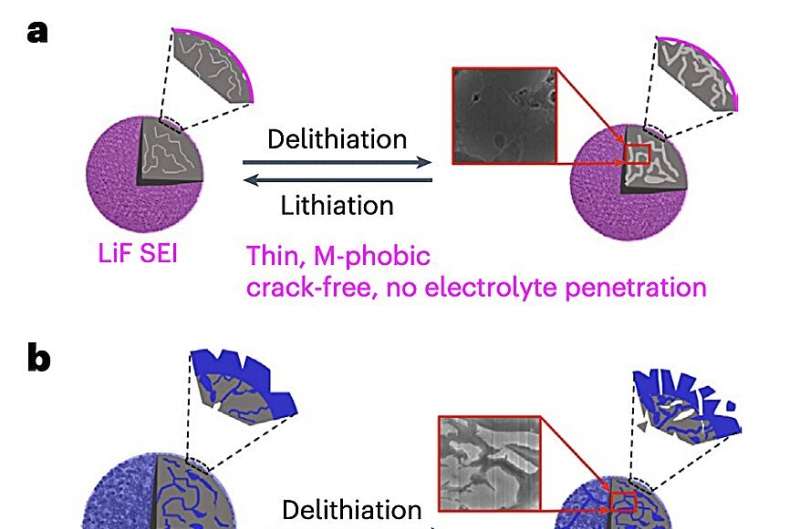
September 10, 2024 by Ingrid Fadelli , Tech Xplore
Collected at: https://techxplore.com/news/2024-09-asymmetric-electrolyte-enables-high-capacity.html
Lithium-ion batteries (LiBs) have become the most widely used rechargeable batteries worldwide. Energy researchers and material scientists have been trying to identify alternative materials that could serve as LIB components, potentially leading to improvements in battery performance and efficiency without significantly increasing fabrication costs.
To date, graphite has been the most employed anode material for LiBs, due to its relatively low cost, light weight and durability. In recent years, however, studies have identified promising alternatives to graphite-based anodes, one of which is micro-sized alloying anodes.
Alloying anodes are based on metal alloys that can react with lithium, such as silicon (Si), tin (Sn) or aluminum (Al). Anodes based on these alloys could have notable advantages over graphite anodes, including a lower cost and the potential of boosting the capacity of batteries.
Despite their potential advantages, micro-sized alloying anodes have so far proved less reliable than graphite anodes. One reason for this is that they often result in a rapid decay in capacity and low Coulombic efficiencies, particularly when combined with electrolytes based on carbonate.
Past studies have found that the solid electrolyte interphase (SEI), the protective layer that forms on the anode during battery cycling, binds too strongly to alloys. This can lead to structural cracks both on the SEI and alloy through which the electrolyte can penetrate, forming new SEI layers while the battery is charged and discharged.
The resulting rapid degradation observed in batteries with micro-sized alloying anodes has so far limited their widespread use and commercialization.
In a paper published in Nature Energy, researchers at University of Maryland and University of Rhode Island introduced a new asymmetric electrolyte that could improve the performance of LiBs with micro-sized alloying anodes.
“Using nano-sized alloying anodes can enhance the cell cycle life but also reduces the battery calendar life and increases the manufacturing costs,” Ai-Min Li, Zeyi Wang and their colleagues wrote in their paper.
“We significantly improved the cycle performance of micro-sized Si, Al, Sn and Bi anodes by developing asymmetric electrolytes (solvent-free ionic liquids and molecular solvent) to form LiF-rich inorganic SEI, enabling 90 mAh μSi||LiNi0.8Mn0.1Co0.1O2 and 70 mAh Li3.75Si||SPAN pouch cells (areal capacity of 4.5 mAh cm−2; N/P of 1.4) to achieve >400 cycles with a high capacity retention of >85%.”
The researchers designed and synthesized a new electrolyte that could perform favorably when combined with micro-sized alloying anodes and high-energy cathodes. This electrolyte is based on N-methyl-N (2-methoxyethoxy) methyl pyrrolidinium hexafluorophosphate, which is abbreviated as NMEP.
“The asymmetric electrolyte design forms LiF-rich interphases that enable high-capacity anodes and high-energy cathodes to achieve a long cycle life and provide a general solution for high-energy Li-ion batteries,” wrote Li, Wang and their colleagues.
To evaluate their electrolyte‘s potential, the team tested it in large LiB pouch cells. Their findings were highly promising, as the cells attained high capacities above 140 mAh g-1 for 200 cycles, retaining more than 85% of their capacity after 400 operation cycles.
The researchers’ newly introduced asymmetric design boosts the compatibility between LiPF6 salt, a key component of LiBs, and dimethyl ether (DME) with low reduction potentials, enabling the reliable formation of LiF interfaces on micro-sized alloy anodes.
In the future, it could be tested on a wider range of batteries with different anode and cathode compositions, potentially contributing to the development of next-generation battery solutions.
More information: Ai-Min Li et al, Asymmetric electrolyte design for high-energy lithium-ion batteries with micro-sized alloying anodes, Nature Energy (2024). DOI: 10.1038/s41560-024-01619-2.
Journal information: Nature Energy

Leave a Reply